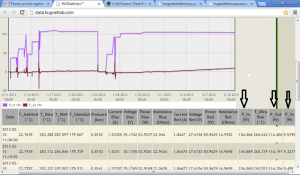That was a nice comet last week… a more spectacular one is due to appear in December
“Cold Fusion: A Big Idea for Minnesota Energy Research” Friday, February 8, 2013, by Tom Robertson, Post Bulletin. (view) The Post-Bulletin is the largest daily newspaper in Southeastern Minnesota.
From Tom Robertson’s article:
- The Hunt’s focus on sustainable living is supported by profits from a wildly successful invention Paul devised in the 1990s. The self-taught inventor patented the “turtle meter,” which allows utility companies to remotely read electric power meters.
- Hunt sold his invention for tens of millions. His company now is using the money for research and development, searching for the next breakthrough invention to sustain the company and its 20 employees.
- That’s where cold fusion comes in. The technology was first introduced in 1989 by two scientists who claimed they were able to produce excess heat from an experiment that combined hydrogen and electricity with various metals.
- When other scientists were unable to consistently replicate the effect, mainstream scientists largely rejected cold fusion.
- When Paul Hunt first started looking into the technology two years ago, he and his son, Ryan, the company’s head of research and development, were skeptical.
- “Both of us looked at each other here and said ‘cold fusion, I thought that was dead. I thought that was fake,'” Hunt said. “We started paying attention to it. And then we started looking at the history of it, and found out that it really is real. It’s being done in labs all over the world.”
- In the company’s research lab, Ryan Hunt, who holds a degree in chemical engineering from the University of Minnesota, recently stood over a pair of small, transparent tubes containing ceramic structures that hold pairs of hair-thin wires. The apparatus is similar to ones he saw demonstrated by an Italian scientist at a conference in Korea last summer.
- Hunt said he and his team achieved the cold fusion effect for the first time just last month.
- The same unexplainable effect has reportedly been achieved at more than 100 other laboratories worldwide. Most have ditched the term “cold fusion” in favor of the term “low-energy nuclear reactions.”
- Hunt Utilities Group has teamed with scientists in Europe to collaborate. They post their data on low-energy nuclear reactions online and invite other researchers to review and comment on their methods.
YET… The following New York Times article appears (with no mention of cold fusion). Was the Hunts’ cold fusion research edited out of the interview material?
New York Times – January 11, 2013, Environment section – Green: A Blog About Energy and the Environment – “In Rural Minnesota, a 70-Acre Lab for Sustainable Living” By Bryn Nelson (post)
Within this laboratory of energy-efficient housing, the Hunt Utilities Group, or HUG, mixes high-tech ingenuity with homespun practicality and a touch of whimsy in its drive toward what Mrs. Hunt laughingly dubs “decadent sustainability. ”
WEIRD… Didn’t the NYT folks go to the Hunt Utilities Group site for background research? Didn’t they realize they were nibbling at the scoop of the millennium?
Did the NYT people read any of the related material… LENR by Paul Hunt or NASA? (NASA)
HUG quote, “For 10 years we have been focused on solar, wind, super insulation, etc. This new energy could make all those things obsolete.”
I doubt that Mr. and Mrs. Hunt, or their son, failed to mention cold fusion research to the NYT interviewers.
What do the Hunts think about cold fusion? Visit the HUG site… (Hunt Utilities Group site) Read the (Feb 2013 coldfusionnow article) which contains the following…
- “Paul Hunt and his son Ryan formed the Hunt Utilities Group (HUG) and initiated the Martin Fleischmann Memorial Project to reproduce and test cold fusion experiments.”
and…
- “They announced the project at the most recent International Conference on Cold FusionICCF-17 in Daejon, South Korea, and since then, have been experimenting with Francesco Celani‘s nickel wire, making surprising discoveries about the material. Their work is open-source and can be found at quantumheat.org.”
NOW…
New York Times is closing its’ “Green: A Blog…” site. They ask, “Follow Our Environmental Coverage” (link)
WHY should I do so?
I wonder what the NYT “Green: A Blog…” writers feel about this? (list) Also at…(list)
Or Andy Revkin? “A Farewell to Green” By Andrew C. Revkin, March 2, 2013 (article)
Readers of the New York Times may want to ask the editors… “What’s up with cold fusion now?”
The New York Times editors may answer…
“Censorship of cold fusion research and LENR engineering is our policy.”
How else is it that the Post Bulletin Beats the New York Times coverage of the ‘cold fusion comet’ appearing brightly in labs…
Like the 70-Acre Lab for Sustainable Living In Rural Minnesota?
“Within science is the art of appreciation; the source of all true inspiration.” – gbgoble2013
Paul et al, Thanks for the HUG! Hunt Utilities Group… LENR research and engineering.
Thank you, Tom Robertson and the folks at Post Bulletin.
Thanks, Christopher Johnson and Journal of the History of Ideas, Harvard University.
Cold Fusion Now
Comet… A long haired star that appears from the unknown.
Comet Etymology
c.1200, from Old French comete (12c., Modern French comète), from Latin cometa, from Greek (aster) kometes, literally “long-haired (star),” from kome “hair of the head” (cf. koman “let the hair grow long”) [Middle English comete, from Old English comta, from Late Latin, from Latin comts, from Greek komts, long-haired (star), comet, from kom, hair.] comet·ary (–tr), co·metic (k-mtk) adj.
Word History: Comets have been feared throughout much of human history, and even in our own time their goings and comings receive great attention. Perhaps a comet might seem less awesome if we realized that our name for it is based on a figurative resemblance between it and humans. This figurative name is recorded first in the works of Aristotle, in which he uses kom, the Greek word for “hair of the head,” to mean “luminous tail of a comet.” Aristotle then uses the derived word komts, “wearing long hair,” as a noun meaning “comet.” The Greek word was adopted into Latin as comts, which was refashioned in Late Latin and given the form comta, furnishing Old English with comta, the earliest English ancestor of our word comet.
“Epistemology and Intertextuality in Early American Cometography”
Christopher Johnson
In the winter of 1680-81 an enormous comet appeared in the nighttime skies of Europe and the Americas. This “blazing star” occasioned numerous treatises, poems, pamphlets, broadsides, ballads, engravings, and woodcuts. Evaluating this cometary copia, the historian of science, Pingré, in 1783 observes:
The world was inundated with writings on these phenomena, on their nature, on their significations; for there were still astrologers and cometomantics [Cométomantiens] … I believe that the languages were not even as confused at the Tower of Babel, as were the sentiments concerning this famous comet.
Pingré’s belated impatience with the discursive flood of “astrologers and cometomantics” echoes of course the more general Cartesian objection to the confusion of words and things, a confusion that L’Académie des Sciences and Royal Society dedicated themselves to eliminating. But the arduous nature of this effort in seventeenth-century Europe is exemplified by the numerous, often-conflicting interpretations of the 1618, 1665, and 1680 comets—to say nothing of the unprecedented “new stars” or novas of 1572 and 1604, which were often treated as cometary phenomena.





